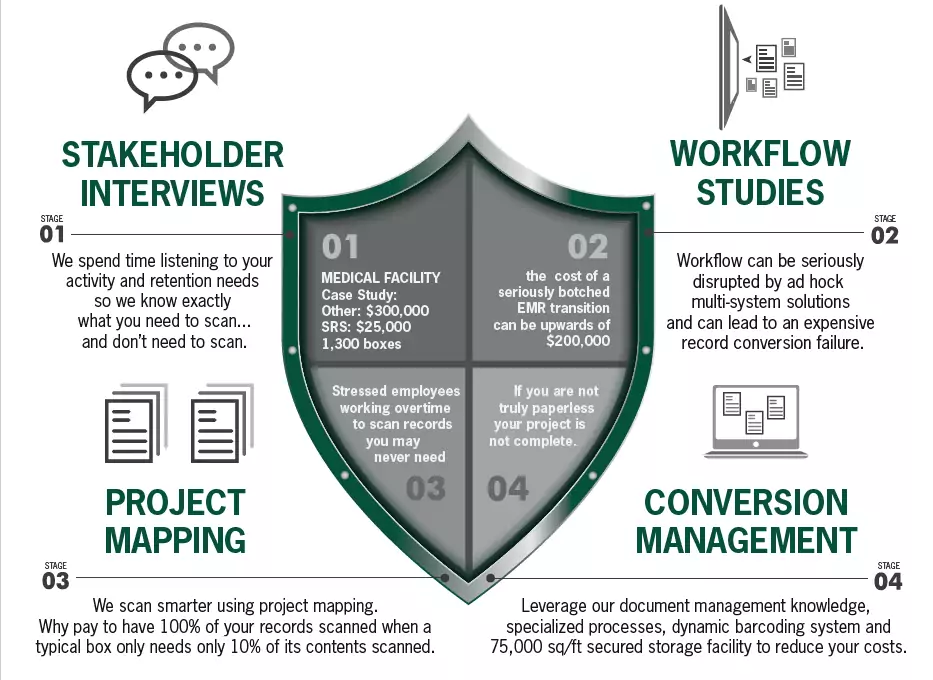Are you making a Strategic Decision or a Buying Decision?
If you are thinking about document management in terms of buying a software and scanning paper, you aren’t solving the problem. No matter where you are in the process of managing digital records, you should clarify your strategy so you avoid costly mistakes like scanning records that will never be needed, continuing to produce paper faster than you can scan it, and failing to fully convert to the new system resulting in the loss of hundreds of thousands of dollars invested in a new technology. We specialize in helping healthcare providers develop an Electronic Health Record Strategy.
Most Healthcare organizations aren’t using their Electronic Health Record software to solve the problem they bought it to solve, they are creating more waste than they were with hardcopy records by scanning things they’ll never need, scanning at the wrong time (for storage, not for improved workflow), and straddling both systems by managing duplicate hard copy/digital records. We help our clients consider their EHR Strategy, instead of thinking in terms of EHR or Scanning purchasing needs.
An EHR conversion isn’t as simple as buying a software and scanners to convert paper, it is about adapting processes to integrate the software into your existing organization without losing billings, reducing the quality of patient interactions, or disrupting your daily operations. EHR Software companies can only do so much to adapt their technology to your organization’s needs. Once they’ve fulfilled their commitment to integrating the software, it is up to you to manage your internal processes to support it, or you risk losing the value of your investment. That’s a big commitment on top of your mission-critical activities. We help our clients develop a plan based on where they are in the process (haven’t purchased software, preparing for an integration, or already integrated and trying to make the most of it).
We develop that plan at no cost, then develop a proposal for the cost of our involvement developing processes that will support their new technology, and efficiently consolidating all records (paper and electronic) into the new system.
Recent examples of our Electronic Health Record Strategy work include:
- Regional Hospital: After conversion they continued creating paper charts that had to be kept because they weren’t just duplicates, their hardcopy/digital records had slight differences so they were required by law to keep both. They approached us about developing a proposal for scanning all of these records to catch them up, but we told them that wouldn’t solve their problem until they changed their system to stop creating physical records. We also showed them how to avoid 90% of the cost of scanning the hard-copy records they’d already created by isolating the elements of the record they needed and leaving the rest in hard-copy form until they met their retention. We helped them develop systems to stop creating paper records and when they needed something out of the existing physical charts we removed from their premium hospital space, we would scan that to them to be uploaded into their software. They no longer have paper charts in their facility, and their processes are now completely based in their EHR. The physical charts that had already been created will have met their retention and been destroyed within the next 10 years.
- Regional Healthcare Provider with 5 locations: After an EHR conversion failed because they didn’t change their systems to stop creating physical charts and the hamster wheel of internal scanning grew to the point that they couldn’t afford the staffing, they threw away a $200k investment in technology and at least that much in labor. We helped them plan their second conversion that focused on changes to their internal processes for creating medical records within the new system and removed their physical records to serve records needs by scan. Because we removed the crutch of hard-copy records, their team relies completely on the software and spent 10% of what they would have spent to scan everything.
- Regional Healthcare Provider with 5 locations: After an EHR conversion 7 years earlier, they were still managing a warehouse of 7000 boxes of records and 3 full time staff with a lag time on records requests of 30 days +, if they could find them at all. Their cost for managing hardcopy records 7 years after converting to an EHR software was about $125k annually. We designed a project that would give them a 30% return on handing over their records for us to develop a comprehensive index, more efficient storage and delivery, and destruction of all records within 10 years, while ensuring that all records would be managed within their EHR going forward.
- Regional Healthcare Provider with 10 locations: We were brought in to plan their second EHR conversion after an initial failed conversion (at a cost of $200k). We developed a system that would remove 3500 boxes of records from 10 locations in 3 counties and reorganize them to minimize their retention requirements and scan records as needed into their new system, training their staff to rely on the new EHR software instead of creating duplicate records and spending countless resources scanning records with a 2% likelihood of ever being needed. Within 10 years they will have destroyed all physical records.
- Regional Healthcare Provider with 6 locations: We were brought in to plan their EHR conversion to cut their cost of scanning hardcopy records by indexing their inventory and identifying appropriate retention schedules, scanning the 2% of records they would need, and training their team to rely on the EHR instead of their hardcopy records inventory.
- Large Regional Non Profit with 30 locations: We caught up back-file scanning of HR records and by studying their document management software and processes, identified a recurring savings of 70% of their internal document management practices. Records were being created in hard copy, scanned, printed, and rescanned between multiple facilities at a cost of $70k annually because no one in the organization had considered how they could accomplish the goal of using their software to manage workflows more efficiently.




